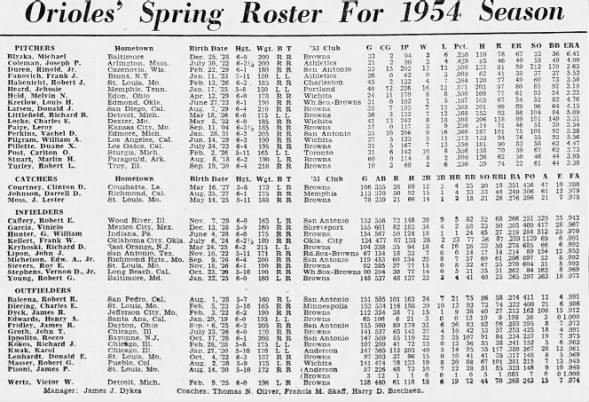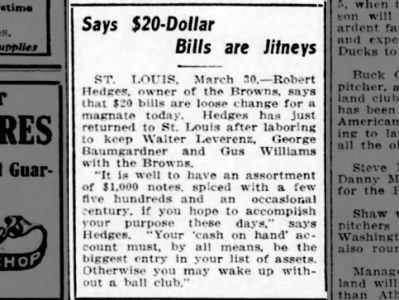Former Chicago White Sox “Jungle Jim” Rivera dies at 96
“Jungle Jim” Rivera, an outfielder on the 1959 “Go-Go” White Sox pennant-winning team, died Monday in Fort Wayne. He was 96. The AL leader in triples in 1953 and steals two years later, Rivera played for the White Sox from 1952 to 1961. He was part of the 1959 team that — led by Nellie Fox, Luis Aparicio and Early Wynn — captured the franchise’s first pennant since 1919. Rivera batted .256 in a career that included short stints with the St. Louis Browns and Kansas City Athletics.
The following is a 2012 interiew with Rivera, who went on to own Captain’s Cabin Restaurant at Crooked Lake in Angola after retiring from baseball.
He once chided President John F. Kennedy for an illegible autograph on a souvenir baseball, telling him, “You certainly have to do better than this, John.” Another time, he boasted to former first lady Bess Truman, “I’m sure sorry my home run beat your club, but it was a helluva wallop, eh Bess?”
For 10 seasons, “Jungle Jim” Rivera played major league baseball, with most of his career spent playing outfield with the Chicago White Sox. The irrepressible Rivera, known for his speed, huge cigars, headfirst slides, and humor was often fodder for sports writers who delighted in his genial unpredictability.
Retirement from baseball saw him take up the reins at Angola’s venerable Captain’s Cabin — a role he relished for 26 years. Now, at age 90, he reflects on a life well-lived.
Your parents moved to New York from Puerto Rico. Describe your childhood.
When I was about three years old, my mother died, and my sister Mary and I were put in an orphanage. When we came out, I was 15, going on 16.
It was a Catholic home for boys and girls. My father would come up and visit once in a while. We had a place in the middle of the convent where you could sit and eat fruit, candy — whatever the parents would bring. They would visit for a couple hours and then go home. Every other year he would show up. I was glad… glad to see him.
After you returned home, you began boxing and continued in the Army.
I loved boxing. I was in the Golden Gloves in New York City. I got the h— beat out of me, but I loved it. I went to the finals one time.
In the Army if you won [the match] on Friday nights, you either got cigarettes, tickets to a movie, or you didn’t get KP. And I didn’t want KP!
You were also a judo instructor and played baseball in the Army before signing a contract to play major league baseball in 1949. Where did you play?
I was signed by the Atlanta Braves, and they sent me to Gainesville, Florida, Class D. I played there, and we won everything — play-offs, batting champ… Then I went to Pensacola, Class A, and won everything there. Next was Seattle, AAA, under Rogers Hornsby.
Hornsby signed you to the St. Louis Browns in 1952, where you played before joining the Chicago White Sox. How did that transpire?
Rogers Hornsby liked anyone who would hustle, and he said one day that he would pay $2 to see me play. I was with the Browns about a month and a half, and then the White Sox bought me.
I started in center field, but when we got Jim Landis, I went to right. Minnie Minoso was in left.
You set several records with the Sox. What were they?
Every time I stole a base, I had to deal with Frank Lane, the General Manager. When I stole a base, I got $100, and when I got thrown out, he’d take $100 off. That was good incentive! I had 25 that year (1955). My 16 triples held up for a long, long time.
Your birth name is Manuel Joseph Rivera. Where did the “Jungle Jim” moniker originate?
We were playing the Dodgers in an exhibition game in Florida, and Don Newcombe was pitching. I got a single off Newcombe — right through the box. When I got on first base, instead of leaning, I was [demonstrates a chimpanzee-like stance]. The announcer says to the newsman, “Look at him! He looks like he’s in the jungle!”
So, I took off for second base, dove headfirst, and they threw me out. It was in the Chicago Sun-Times the next day: “Jungle Jim”. Ah, well, it was better than some of the things I’ve been called.
You became famous for that headfirst slide.
I just did that automatically. If you dive headfirst you can see where the ball is coming from. It doesn’t hurt to slide like that if you do it right. I would rather have a broken finger than a broken ankle.
Colorful, unorthodox, bold, brash… what antics earned you those descriptions?
One night I had a home run to beat Kansas City. Bess and Harry Truman always sat between first and home in the upper deck. You could see the Secret Service guys all around them.
After the game we saw a big crowd at the front of the stadium. Harry Truman was in the middle. I walked up and said, “Hi, Harry. Jim Rivera and George Kell… Where’s Bess?”
There was this big black Cadillac, and Bess was in the back seat. I went over and said, “Hi, Bess. I’m the one who hit the home run and beatcha.”
Describe the encounter with JFK during a Washington Senators game.
I knew that every year on opening day, the president would throw the ball out, and I knew from watching films of him playing touch football with the family that he had a pretty good arm. Everybody was on the pitcher’s mound, but I went back further.
So here comes the ball… and I caught it.
It was later reported that you “danced a hilarious jig and then raced to the presidential box in quest of an autograph”. That autograph was barely legible. What did you say?
Something like, “what’s this? Is that your signature? It’s just a scribble!”
After 10 years in the majors, you retired to start a new chapter. What brought you to Captain’s Cabin?
My first wife lived in Angola, and her brother Bill and I bought the restaurant. It was a new role for me.
Besides the view of Crooked Lake with it’s stunning sunsets, what are some of your favorite memories of the Cabin?
On weekends a combo played for dancing. I had a box full of “instruments” I passed out, and everyone played along. Spoons was my specialty. Every year on a Sunday before Christmas, I fixed a chicken dinner for the residents of the County Home. New Year’s Eve was a big event, starting with a decorating party and ending with breakfast.
Customers from Indiana, Michigan and Ohio… euchre games… relaxing on Doc Nesbitt’s pontoon on Lake James… I loved my time at the Cabin, and I loved the people there. I wish I could do it all over again.
Life sometimes tossed you a curveball. Reflect on your experiences.
I’ve met so many people, from Presidents to ballplayers to fans and little leaguers, and the good things in life outweigh any hardships along the way. I have the two most important things in life — a wonderful wife and great friends — and, I might add, great memories.














